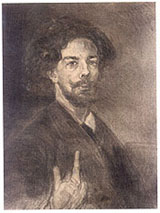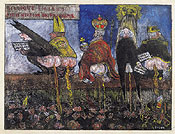The browser will either open the file, download it, or display a dialog.
|
"Between Street and Mirror: The Drawings of James Ensor" Catherine de Zegher, ed., with essays by Robert Hoozee, Susan M. Canning, Marcel de Maeyer, Herwig Todts, and chronology by Xavier Tricot |
|||
| James Ensor's triumphal reentry into New York this past spring took place at the Drawing Center, a relatively small but innovative arts institution in a city filled with museums (fig. 1). The exhibition "Between Street and Mirror: The Drawings of James Ensor" comprised ninety-six works on paper created between 1880 and 1901. In an era that witnesses multiple shows of the works by French Impressionists in any given year, Belgian artists active during the same period have fared less well in the popular imagination in the United States. Indeed, Ensor remained virtually unknown in this country until 1987, when the Getty Museum acquired Christ Entering the City of Brussels in 1889 (1888). Since that time, museum visitors have flocked to the museum in Los Angeles to see this Ensor painting along with the other works by Belgian artists that have been accessioned since then. It nonetheless continued to be a rare moment when Ensor's work was exhibited in this country. This oversight changed radically and positively with the opening of "Between Street and Mirror." Easily one of the more popular shows the Drawing Center has organized in the last few years, it was a revelation for the public and scholars of Belgian art alike. | |||
| Although Ensor's etchings formed part of a small exhibition two years ago at the Museum of Modern Art, New York, and a group of his hand-colored etchings were shown last year at Shepherd Gallery, also in New York, there have been no major retrospectives devoted to his drawings in the United States until now. The last large-scale Ensor show in this country was held forty years ago at MOMA.1 Part of this neglect has been based in the general primacy given to painting over drawing and in the dominance overall of Ensor's monumental canvas at the Getty, which has overshadowed the diversity of theme, medium, and technique in his oeuvre. The Drawing Center show demonstrated handily that Ensor's investigations in drawing were not only vast and fundamentally productive for the artist but also constitute an important contribution to the history of late-nineteenth-century art. | |||
| "Between Street and Mirror" focused on Ensor's most creative period, between 1880 and 1895, when he was a crucial figure at the center of Belgium's avant-garde activities. It documented both Ensor's role as an innovator and his status as a precursor of many early-twentieth-century experiments into abstraction. The show was curated by Catherine de Zegher, director of the Drawing Center, and Robert Hoozee, director of the Museum voor Schone Kunsten in Ghent, with the assistance of Susan M. Canning, professor of art history at the College of New Rochelle. | |||
| The normally white walls of the large gallery of the typical Soho building were painted a blood red, a tone found in many of Ensor's drawings that echoes the nineteenth-century bourgeois interiors he explored and often mocked. The installation was ordered around five major themes in Ensor's art. The show opened with the artist's early renderings of street scenes seen from the window of his studio above his parents' home and the extended family's mask shop in Ostend. Ensor's first drawings were created mainly in charcoal and document both the artist's training at the Brussels Academy of Fine Art (1877-80) and his early adherence to the tenets of both academic art and its rival, realism. Many of these drawings contain a bird's-eye view of street life or are copies after works by earlier masters, including Daumier and Courbet; others begin to presage Ensor's later forays into bizarre and unexpected juxtapositions of scale and subject.2 His incorporation of cross-hatching, dark tonalities, and other traditional touches gives way, within a short time, to the introduction of color and a freer hand, beginning with the sketch for his first major mask painting, Scandalized Masks (1883; Courtesy Sabine Tavernier, Ghent and Faggionato Fine Arts, London). | |||
| From here, a large group of his investigations into the divergent styles of Impressionism and its aftermath were presented. Ensor inserted his likeness into many of his most biting images. An early example is the Düreresque/Courbetian My Portrait (1884; Musées Royaux des Beaux-Arts de Belgique, Brussels), in which he literally and figuratively points to himself as part of an impressive artistic continuum. Later, in The Dangerous Cooks (1896; Museum Plantin Moretus, Antwerp), Ensor's decapitated head is served up on a bed of smoked herring (hareng saur) by Octave Maus, the impresario of Les XX. This image documents Ensor's frustration with Maus, who had, beginning in 1886, switched his allegiance from the Belgian to the Neo-Impressionist Georges Seurat and his Belgian and French followers as the most important apporteurs de neuf. | |||
| Ensor also inserted his likeness in many of his images of Christ. In the section devoted to the series "Visions: The Aureoles of Christ," his spare yet frenetic line comes into play most dramatically. All but one of the drawings from this cycle was included in the installation. The magisterial, monumental drawing The Lively and the Radiant: The Entry of Christ into Jerusalem (1885) was probably excluded from the show because of its delicate condition and its importance to the Museum voor Schone Kunsten in Ghent.3 Despite this crucial absence, the show contained some real gems. | |||
| No exhibition of Ensor would be complete without his justifiably famous images of masks and skulls. The organizers did a fine job of presenting the range of technique and commentary found in these subjects. The show ended with a large grouping of Ensor's visual social critiques-among them, the always shocking hand-colored etching Doctrinaire Nourishment (1889; Ghent Museum voor Schone Kunsten) (fig. 2), and the magisterial The Strike; or, Massacre of the Ostend Fishermen (1888; Royal Museum of Fine Arts, Antwerp). | |||
| This exhibition provided one of those rare opportunities, in an era of blockbusters, in which one could actually learn a great deal. Many of the drawings have been reproduced in publications over the years, but Ensor is an artist whose works are best examined up close and personal-especially those images in which he used a technique of layering imagery to create almost apparition-like details. Many of these drawings have been exhibited less frequently during the recent spate of Ensor exhibitions in Europe, and, even if they are familiar from reproductions, their freshness and intricacy inevitably made it seem as if they were being shown almost for the first time. | |||
| The accompanying catalogue was lavishly produced and contains color or halftone illustrations of each of the drawings on display. All but one of the texts were published previously in conjunction with exhibitions of Ensor's work in Europe. Normally, one might argue that such duplication is a problem, yet in this case the essays by the European scholars Robert Hoozee, Marcel de Maeyer, Herwig Todts, and Xavier Tricot are now available in English for the first time. Hoozee's "Drawings and Etchings"4 acts as an overview of Ensor's career as a painter and a draftsman, exploring the many shifts Ensor's art took over his long and productive career. De Maeyer's "Mystic Death of a Theologian"5 focuses on the problem of dating Ensor's first monumental drawing of the same title. This large work was rendered, at least in part, while the artist was still a student at the Brussels art academy in 1880. Ensor returned to the piece half a decade later and both expanded it and overlaid it with new imagery. In the process, he transformed the image from an homage to Rembrandt and other Old masters into a work that presages many of his most creative subjects. Ensor exhibited the reworked version of the drawing at Les XX in 1886 to great acclaim. Its presence confirmed the artist as a leader of the new art in Belgium. | |||
| As much a prolegomenon for future studies on Ensor as it is an analysis of his tightrope walk between realism and the grotesque, Todt's "The Grotesque in Ensor's Oeuvre"6 argues that any simplistic notion of either approach falls apart when examining Ensor's oeuvre. He argues against a view of the artist as a cynical, misunderstood martyr,7 and proposes, instead, the necessity of situating Ensor within a much larger artistic and social discourse. | |||
| Taking up the challenge in Todt's essay, Susan Canning's "The Devil's Mirror: Private Fantasy and Public Vision," written expressly for the catalogue, provides the panoply of contextual analyses needed to understand Ensor's drawings. This text also comprises a synthetic overview of recent scholarship on Ensor and caricature, crowd theory, scatology, and the social history of Belgium at the turn of the twentieth century. By focusing on the binary oppositions of public and private spheres, reality and visionary, high and low culture, male and female, contemporary and historical, Canning presents a nuanced view of Ensor's art. She argues that his self-portraits and images of women are neither more nor less revealing of his autobiography or of the often-recounted "facts" of his supposed misogyny. When he turned his pencil to the world of contemporary social and political concerns, Canning argues, "his drawings provide a model of the engaged activist artist at his most bitingly humorous and satirical best while challenging the ways in which social critique can be presented and perceived" (p. 73). As an ensemble, the essays in this volume provide an important contribution to Ensor studies. | |||
| One can hope that the popularity and success of "Between Street and Mirror" is an indication of things to come. If so, then perhaps museum visitors in other cities will soon have an opportunity to become acquainted with the woefully underappreciated yet crucial figures of early modernism who hailed from Belgium. | |||
| Sura Levine Hampshire College Amherst, Massachusetts |
|||
|
1. Libby Tannenbaum, James Ensor (New York: Museum of Modern Art, 1951; reprint 1966). 2. Throughout his career, Ensor drew from illustrated journals and made copies after Renaissance, Baroque, Rococo, and modern masters. Some of his drawings include references to other paintings in a kind of method of visual sampling, such as The Dream: Vision toward Futurism (1886; private collection; courtesy of Bounameaux SPRL, London), in which the decapitated heads of the sixteenth-century Belgian heroes Egmont and Hoorne, depicted to great acclaim in 1851 by the academic artist Louis Gallait, are translated into terrified dreamers of the chaos and grotesqueries of the future. 3. Easily one of Ensor's most famous works on paper, this drawing is also the artist's largest (206 x 150.3 cm [81 1/16 x 59 3/16 in.]). It is an important precursor to Christ Entering the City of Brussels. 4. Robert Hoozee, "James Ensor: Tekeningen en etsen," in James Ensor, 1860-1949: Schilderijen, tekeningen en grafiek-een selectie uit Belgisch en Nederlands bezit, ed. Jos. de Meyere (exh. cat., Utrecht: Centraal Museum, 1993), pp. 27-49. 5. Marcel de Maeyer, "De mystike dood van een godgeleerde van James Ensor," Jahrbuch der Koninklijk Museum voor Schone Kunsten, 1962-1963 (1963), pp. 54-155. 6. Herwig Todts, "Le grotesque dans l'oeuvre d'Ensor," in James Ensor, ed. Thérèse Burollet and Lydia M. A. Schoonbaert (exh. cat., Paris: Musée du Petit Palais, 1990), pp. 43-49. 7. See, for example, Michael Kimmelman, "The James Ensor Show: A Haunting Beauty in a Carnival of Follies," New York Times, 11 May 2001, section E, p. 31. |



